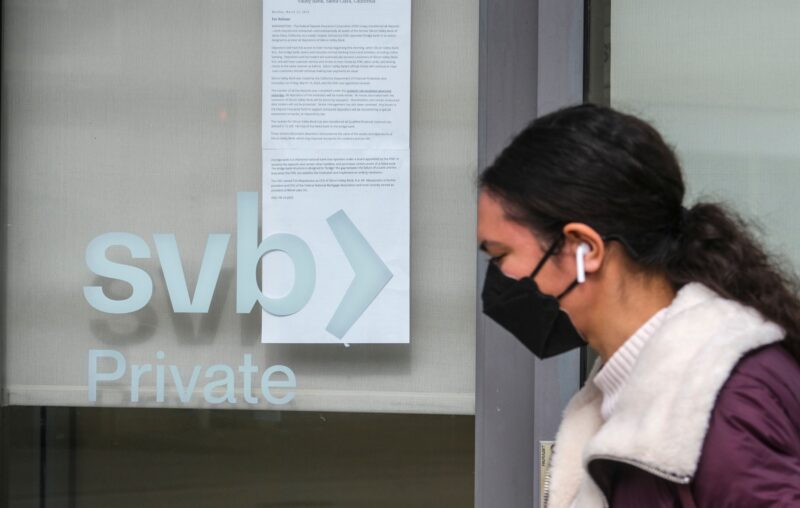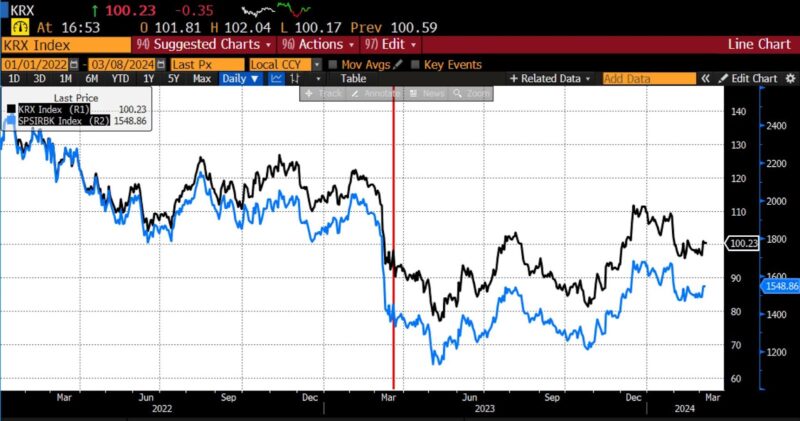Another Year, Another Crisis

The one-year anniversary of the collapse of Silicon Valley Bank (SVB) is upon us. And while some of the factors behind that catastrophe have been tamped down, a new crop of problems have emerged to cast a shadow over the banking system and the health of the US economy. In the year since, only the sources of difficulty have changed.
In March of 2023, the size and rapidity of the Fed’s rate hikes had driven a handful of banks with highly concentrated deposit bases into duration gaps, triggering runs and ultimately failure and government seizure: Silicon Valley Bank, Signature Bank, First Republic Bank, Heartland Tri-State Bank (a complicated situation), and Citizens Bank of Sac City Iowa. Within that same month, Silvergate Bank voluntarily liquidated, and Credit Suisse First Boston collapsed. The demise of the latter owed not to rapidly rising interest rates, but a litany of accumulated blows over the years ranging from scandals, bad strategic choices, and periodic trading losses.
Hundreds of other US banks, though, were sitting on between $600 and $700 billion of unrealized losses in long-dated US Treasury and agency securities. To ensure liquidity the Fed unveiled the newest in a growing catalog of emergency programs, the Bank Term Funding Program (BTFP). The BTFP provided yet another “window” for financial institutions to pledge securities over a defined term: this one lending against positions at their par values, a clear sign of the immense damage that the Fed’s delay in fighting the inflation (that they themselves caused) wrought. That lending window closes today.
As March 2023 became April and then summer, the inevitable questions came: “Are we out of the woods? Will more banks fail? Is this the start of another 2008?” Yet by July 2023 the KBW Regional Banking Index and the S&P Regional Bank Index were headed higher and the general view that the crisis was over took hold. The common wisdom now holds that last year’s bank problems were isolated to a small corner of the universe of financial institutions. More importantly, the troubles were not systemic, at least not in the regulatory sense.
KBW Regional Bank Index and S&P Regional Bank Index, 2022 – present

But that’s not completely true. Moral hazard was, as it often is in such cases, ratcheted up. In the most recent episode, depositors of several of the failed institutions with tens of millions of savings in excess of the Federal Deposit Insurance Corporation (FDIC) limit of $250,000 were immediately made whole. Ironically, despite the current administration’s loud and vocal opposition to “junk fees” at banks, they are exactly the means by which the expense to rescue venture capital firms and their portfolio companies will be recovered from mom and pop accounts throughout the US banking system.
Unrealized bank losses now exceed $2 trillion. Those are paper losses, thus unrealized, but their impact on regulatory minimum capital requirements is beginning to collide with yet another source of financial jeopardy. The pandemic policies which forced countless firms to operate from home taught business owners and managers that a huge source of overhead, commercial rents, were (to use the governments’ own parlance), nonessential. Company owners were more than happy to jettison a significant operating expense, but that flight has been costly to both the owners of commercial real estate and the banks that lent heavily to build, purchase, and manage those structures.
One year after the collapse of Silicon Valley Bank and a handful of others, with hundreds of banks sitting on impaired securities, rapidly declining values on commercial real estate loans are further pressuring banks. Plunging rates of occupancy coupled with high interest rates have made writedowns and collapsing valuations commonplace, with an average decline in office space properties of at least 25 percent as of February 2024.
There are anecdotes of once loftily-appraised buildings and portfolios trading hands at $1, and the opacity of those markets leads to a troubling dynamic. Eventually all commercial real estate will need to be reappraised for refinancing, which will inevitably be at higher rates, given the Fed’s tightening campaign. With a $900 billion wall of refinancings coming, should banks with loans out to ventures dissipating in value raise capital preemptively, liquidate some of their beaten-down bond positions, or sit tight and wait to see how the valuations of the assets underlying their particular loan portfolios fare? Surely some buildings and complexes will evade the winnowing markdowns, while others will be utterly wrecked. Again owing to the nature of this most recent dilemma, systemic failures are not likely. But a tightening of credit, even if the Fed is lowering rates by then, will likely drag down economic growth. Some banks may fail, and while the liquidation of malinvestment runs its course, large commercial vacancies are likely to add to rising urban blight in the United States.
One year ago at this very time, the question was: how bad will it get? And this year the question is: how bad will it get?
If it seems like over the past few decades America has stumbled drunkenly from one crisis to the next, that’s because it has. As Eichengreen and Bordo wrote in 2002,
[A] randomly selected country had a five percent probability of experiencing a crisis in a randomly selected pre-1914 year. Since 1973, in contrast, the corresponding probability has been twice as high (10 percent for the same sample of [industrialized] countries, 12 percent for the expanded sample, the latter reflecting the even greater incidences of crises in low-income developing countries. While [as of 1998] the frequency of banking crises was roughly the same before 1914 and after 1972, currency crises were much more frequent in the final quarter of the 20th century (and, as a result there was a growing frequency of both banking and currency crises together).
It certainly seems as if, after 2008, the pace of economic emergencies in or close to the United States has accelerated. Not long after Lehman failed there was a sovereign debt crisis in Europe (2010 – 2012), the Flash Crash (May 2010), a domestic debt ceiling crisis (2011), the “taper tantrum” (2013), the collapse of a large portion of the oil industry between 2014 and 2016, market volatility arising of tariff policies between 2018 and 2019, and then scores of crises arising from COVID policies after March of 2020.
Perhaps most emblematic of the increasing pace of economic problems are the embattled depositors of the now shuttered Signature Bank of New York, shut down by state regulators on Sunday, March 12th, 2023. The bank was heavily involved in crypto businesses, a sector which was started and grown largely out of distrust of the increasingly interventionist, fiat money central banking era. As the Silicon Valley Bank problems grew on the other side of the country, worries about Signature Bank’s risk controls led to its seizure. Its customers — many of whom businesses and individuals already wary of fiat finance — were moved to New York Community Bank (NYCB), a storied Queens-based real estate lender. That firm, less than one year later, is now thickly ensnared by the burgeoning real estate morass.
Stock prices of Signature Bank of New York (black) and New York Community Bank (blue), 2022 – present
(Source: Bloomberg Finance, LP)
And on it goes. Asset price volatility and changes in real interest rates have been stalwart challenges for as long as there have been financial markets, however simple or crude. What’s increasing the tempo of upheaval are newly ascendent forms of risk, all of which are next to impossible to measure and increase financial vulnerability: moral hazard, increased incentives and opportunities to reach for yield, interest rate expectations, and multitudinous systemic connections. (It would be inaccurate to suggest that these types of risk did not exist in the past, but in fact they were rare and minimal in their influence.) From inflation to a Fed tightening cycle, to banking losses and now real estate tremors, we again find ourselves climbing tenuously out of one hole only to collapse limply into another. Until the root issues of financial fragility are confronted and resolved — an fiat currency and the escalating time-preference of managerial behavior and business plans it engenders — the revolving door of economic crises will continue to turn. Hopefully I won’t be writing another such article in March of 2025; the odds are, I will.









